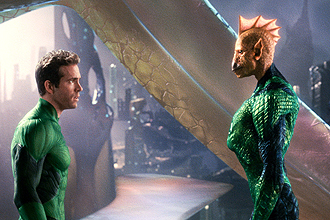"Green Lantern" Film Taps Tulane Expert
What does a dead space alien really look like? When the Green Lantern movie crew, filming in New Orleans, needed to know if their special-effects creations were believable, they turned to Tulane biologist and longtime science fiction fan Bruce Fleury for advice.

In a scene from the movie, Ryan Reynolds, left, portrays the Green Lantern, with Tomar-Re, an alien member of the Green Lantern Corps, voiced by actor Geoffrey Rush. (Photo courtesy of Warner Bros. Pictures and DC Comics)
“The movie's prop people first contacted me to find out what books a space-struck kid would have been reading in the '60s,” says Fleury, a professor of practice of ecology and evolutionary biology. “When they walked into my office and saw my books about outer space and life on other planets, they said, 'We've found the person we were looking for.'”
After meeting with director Martin Campbell, Fleury was pulled deeper into the moviemaking process and was dubbed the crew's “xenobiologist,” or expert on alien life-forms.
Fleury critiqued the model of the dead alien who transferred his powers to the film's lead character, Hal Jordan. “I had to view his body while it was still headless and handless, just coming out of the prop room. The question was, does this look alien enough? Yes even without a head it looked pretty alien!” says Fleury.
Numerous Tulane people contributed props and expertise to the movie, says Fleury, including the alien autopsy and lab scenes.
“I worked with actor Peter Sarsgaard to develop his character, Hector Hammond, a mad scientist,” says Fleury.
Villain Hammond started out mildly enough as a biology teacher at fictional Coast City College. The moviemakers decided to make some changes after meeting with Fleury, a real-life biology professor.
“They hooked me up with Peter, and I had a couple of sessions one-on-one with him,” says Fleury. “He morphed into a microbiologist, and the lecture that he gave is word for word from a lecture that I give on “Evolution in Human Health and Disease,” a course I teach.
“I gave him some of my best lines!”
